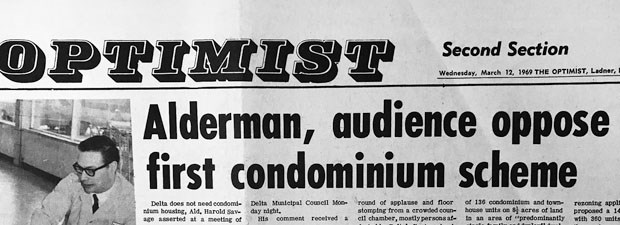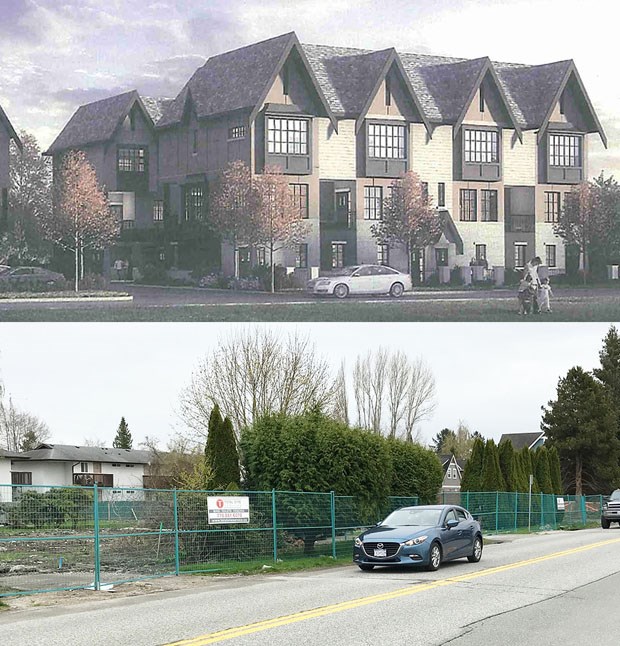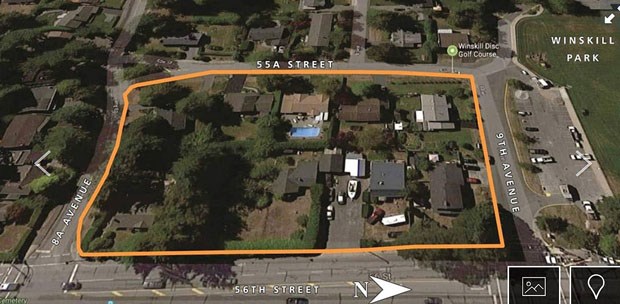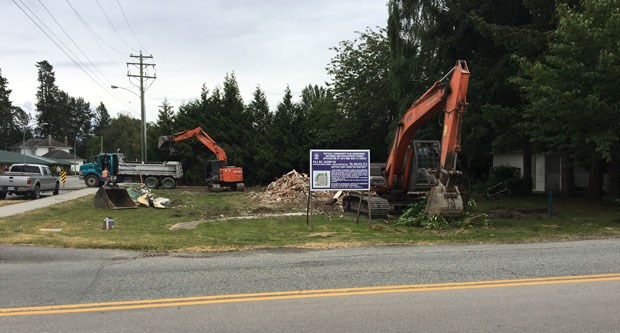It’s been 50 years since construction began on Delta’s first condo complex, a form of lower cost housing that was controversial then and continues to be today.
During the building boom in the years following the opening of the George Massey Tunnel in 1959, Delta grew at a mind-boggling pace, but attitudes toward higher density housing in the burgeoning suburb of detached single-family homes on spacious lots were not all that welcoming.
In 1969, despite much neighbourhood opposition, the first condo complex was built on 57A Street in Ladner, following other Lower Mainland municipalities which had already allowed that type of housing.
Several more applications were submitted to the city that year, prompting council member Harold Savage to remark during a Delta council meeting, “We don’t have to pack everything into Delta. There is lots of room elsewhere.” He received a big round of applause from the audience.
At the time council was also wrestling with two applications for garden apartments in the Delta Manor area, proposals that angered nearby homeowners.
“We moved out here from the city to get away from apartments,” resident Robert Bunston told council in February of 1969.
That summer, remarking on an application for a change in zoning to allow for condos as well as row homes, Savage bluntly told his colleagues such housing wasn't wanted in Delta. During another debate that year, Savage described condominiums as "penitentiaries within our residential areas."

In response to claims by one council member that other municipalities were adding such housing without any problems, then mayor Dugald Morrison countered, “What most councils are afraid of is they will become slums.”
Council member P.L. Shields that year bluntly asked his colleagues about their social responsibility to provide housing for younger people, an argument which didn’t resonate at the time.
It’s one that’s gaining traction these days as sky high real estate prices have made it increasingly difficult for young people to get into the market, with smaller, higher density units the only avenue toward home ownership.
Figures from the Real Estate Board of Greater Vancouver show that a median household income can’t afford the mortgage payments on even the cheapest single-family home in Delta. What’s more, according to 2017 sales figures, only 56 per cent of condos were considered affordable and just six per cent of townhouses fit that classification.
With 80 per cent of Delta’s housing stock made up of single-family homes or duplexes, it doesn’t leave many options for those looking to break into the market. It also limits choices for those looking to downsize after years in the family home.

Fraser Elliott, who heads the number one real estate team in South Delta for the past nine years, believes the areas around the town cores in Ladner and Tsawwassen must densify to provide housing for both segments of the market. He said there are opportunities to do so in both communities but Delta’s Official Community Plan is badly outdated.
He points to a condo building being proposed for Hunter Road in Tsawwassen, arguing it should be six storeys, not four, in order to provide density that’s in keeping with the demands of today’s market.
“The building across the street is, what, 30 years old and it’s four storeys, so we’re basically trying to address today’s housing issues with a 30-year-old plan.”
Elliott, who maintains how a piece of property is redeveloped makes a huge difference in the price of the new units, calls the process of tearing down an old single-family home and building a larger one “luxury redevelopment.” He contends the new house, valued somewhere in the neighbourhood of $1.8 million, would likely be bought by someone moving out from Vancouver.
“That type of redevelopment does nothing for affordability,” he said.
By contrast, he sees replacing some single-family homes with townhouses and condos as a way to create housing stock that’s within the reach of many more buyers.
“Developers are looking to build these kinds of projects because that’s what people want. They’re not going to build something people won’t buy. Redevelopment only happens because of demand.”
In an interview earlier this year, Satish Sharma with Maple Leaf Homes, which is behind a couple of high-rise and other high-density projects in Delta, explained their developments are mostly aimed at addressing the lack of entry-level housing as well as units for those wanting to downsize.
Sharma said the market has slowed due in part to new mortgage rules making it tougher for buyers, which is why people are seeking smaller units at a lower price.
“It’s become all about price point and the banks are only approving people for so much mortgage, so it doesn’t leave them with much options,” Sharma explained.

Long-time Delta-based architect Brian Hart said opposition to higher density in existing neighbourhoods varies according to the scale of a proposal with smaller townhouse projects that better blend having seemingly much less resistance.
“I’ve been doing mostly infill, and I’m convinced the smaller projects contribute far more to a community. I don’t really care about the density, per se. If you can get two or three lots and you build 10 or 12 units on it, more power to you. We need the housing units.
“What’s important about that is you get a much finer grain of development and it disrupts the neighbourhood a lot less. It’s clear that the large consolidations have killed neighbourhoods but the smaller consolidations have been able to maintain the scale of neighbourhoods, so consequently it has less negative impact and in two or three years people can hardly remember there was an issue.
“That was the case with the very first coach homes. It took four years to get approval for three houses with coach homes, but now nobody can even tell you that those houses are any different,” Hart added.
Agreeing that the political decisions of past councils have put Delta in its current predicament, Hart said few areas of the Lower Mainland are going through gentrification compared to U.S. cities where the attitudes have switched from NIMBY (not in my back yard) to YIMBY (yes in my back yard). That’s because millennials who are in an “I have to find a house” part of their lives appreciate the density, he explained.



